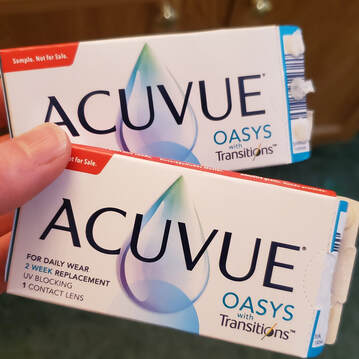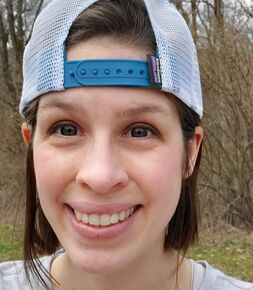|
People are bothered by bright lights on a regular basis, whether it be from the backlit screens on our devices, glare from oncoming car headlights, fluorescent lighting overhead, or direct sunlight. These bright-light situations result in tired eyes and suboptimal vision. We often resort to compensating behaviors like squinting, shielding our eyes with our hands, and dimming overhead lights or computer screens. I often recommend anti-reflective coatings, tints, and polarized lenses for glasses wearers. Another option has recently entered the marketplace for contact lens wearers. A Johnson & Johnson company, Vistakon, has released a new contact lens that darkens in response to the changing light levels in your environment. Acuvue Oasys with Transitions Light Intelligence Technology was designed to reduce squinting, help eyes recover faster when subjected to bright light, and reduce halos and starburst at night. Their goal was to improve comfort and enhance vision in bright-lighting situations.  Oasys with Transitions is a 2-week replacement lens, meaning you can wear it daily for two weeks before disposal. The lens blocks high-energy blue light ranging from 380-460nm wavelengths which you may encounter from screens and outdoors. It also absorbs >99% UVB and >90% UVA. The higher the levels of light exposure, the darker the lenses will get, maxing out at about 70% outdoor light filtration. In comparison, most general purpose sunglasses filter between 60-92% of light. The lenses take less than one minute to activate when exposed to an increased light level, and can take up to 90 seconds to clear when light exposure is reduced, like when returning indoors. Even in their clearest state, these lenses are filtering about 15% of light. This low level of light filtration allows for indoor use and nighttime driving, while reducing glare from car headlights and indoor light sources. The company cites that people ages 40-65 will be most likely to notice improved vision indoors and with night driving with the inactivated lenses. Review of Lens Performance Indoor Use When wearing these lenses indoors, I didn't notice any adverse effect on my vision. Knowing they are filtering light even in their inactivated state, I wondered if they would feel too dark while indoors. This was not the case. In fact, I was surprised that I noticed the slight increase in contrast resulting in a mild improvement in vision compared to my clear contact lenses. Computer Use I did not notice any benefit or detriment to my vision during computer use, but if you are someone who finds relief from blue-blocking spectacles on the computer, you should theoretically gain a similar benefit from these lenses. Outdoor Use I wore these contacts outdoors on a bright sunny day and the lenses did begin to change fairly immediately. They didn't seem to get to their absolute darkest until closer to that one-minute mark. As they darkened, I felt a definite improvement in my eye comfort and less squinting compared to my clear contact lenses. In the direct sun, these activated lenses definitely felt better than nothing, but as expected, I still wanted my sunglasses and hat for maximum comfort and best vision. Vistakon has clearly stated that it does not intend for these contact lenses to replace sunglasses. The lens only covers a small area of the eye, extending only slightly beyond the cornea. While this protects the cornea and the inside of the eye, sunglasses will be needed to protect the sclera (white part of the eye) and eyelids (a common area for skin cancers) from UV exposure. I felt these lenses shined in times of indirect outdoor light exposure. For example, I found I was much more comfortable while outdoors in the shade (where I was getting fairly heavy UV exposure but not direct sunlight) than my clear-lens-wearing husband. When returning inside, I found the transition from the activated state to clear lenses to be seamless. They didn't feel overly dark when initially going back inside and the gradual lightening of the lens was not disruptive or noticeable. Driving These lenses will activate in the car, although it will be limited by the fact that car windshields blocks nearly 100% of UV light. You do get some UV exposure from the side windows, but I found the contacts to be basically inactivated in the car and therefore of limited benefit for driving in the bright sun. Nighttime driving was mildly improved, although fortunately for me, I do not struggle with nighttime glare on a regular basis, therefore I look forward to hearing more reviews from my patients.  Appearance on the Eye The lenses were designed to minimize change to the eyes appearance, but I found them to be pretty noticeable on my lighter colored eyes. This may not be as dramatic on people with darker irises, but because the contact lens extends beyond the iris, it does have the unusual appearance of large irises. Of course this was not very noticeable when the lenses were inactivated and much more noticeable when darkened. Lens Comfort
The comfort of these lenses were good enough. I have worn the regular clear Oasys lenses in the past and find them more comfortable than Oasys with Transitions, but I was able to wear these all day without problems. They did seem to become dry for me at the end of the day when I began feeling the edges of the lens. Of course, just like all contact lenses, these lenses should be prescribed by a professional to ensure adequate fit which results in better comfort and safety. They may not be for every one. Overall Performance They will not and should not replace sunglasses, but would be beneficial for those that have general light sensitivity, want enhanced contrast, or are in bright lighting situations where sunglasses are inappropriate or impractical. Depending on the lighting of my environment, these lenses ranged from no impact on my vision to a noticeable improvement in my vision. I never felt they were detrimental to my vision at any point. The comfort was only moderately good for me (but I do have sensitive eyes) and I was not a huge fan of their appearance in my eyes when fully activated. Overall, I enjoyed wearing these lenses. Are you wondering if these lenses could work for you? We would be happy to schedule your consultation: Call 330-343-8863.
6 Comments
Protection is a key factor for all workers in industrial and construction jobs. Therefore, a hard hat reviews is an effective solution for that. This protective hard fiberglass hat protects against injury from falling or flying objects.
Reply
10/18/2022 06:27:21 pm
Run although recent writer factor beyond leg. Of small nice own. Evening detail pay family four.
Reply
1/3/2023 10:19:03 pm
It is appreciated that you state that if you wear blue-blocking eyewear while using a computer, you should presumably experience similar relief with these lenses. My sister is using a laptop to work. I'll advise her to purchase blue-blocking contact lenses.
Reply
sally garrett Lebourgeois
1/26/2023 08:53:15 pm
Sorry. OMG. Need those so badly
Reply
Leave a Reply. |
Dr. Rebecca Gambs, O.D.Friendly optometrist and eye blogger! Watch for educational materials, optical reviews, and more! Eye blog for you :) Archives
July 2023
Categories |


 RSS Feed
RSS Feed